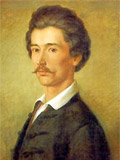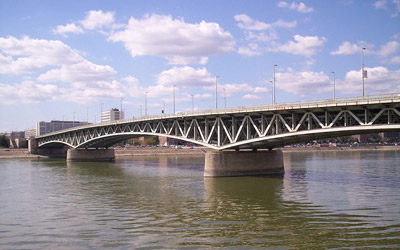Petofi Bridge
Petofi Bridge is situated southwards from Liberty Bridge over the Danube. It is named after the renowned Hungarian poet and revolutionist Sándor Petőfi. Prior to that, it had been called Miklós Horthy Bridge.
Its construction was started in 1933 to the plans of Pál Álgyay Hubert. Structure-wise, it is a deck truss bridge, lacking the usual grandiose ornament of Budapest bridges. At that time, Hungary was being quite pessimistic and fighting political and economic problems, so that the main aim was functionality rather than beauty. The inauguration of the bridge took place on 12 September 1937, and it was named after Regent Miklós Horthy.
 Sándor Petőfi (1823-1849) |
The old bridge existed only for a few years because, as the other bridges in Budapest, it was blown up by retreating German troops at the end of World War II on 14 January 1945. Following this, the Soviet Army established a provisional bridge on its ruins. Eventually, the bridge was rebuilt between 1950 and 1952. The repeated inauguration of the bridge took place on 22 Novembr 1952. This time, it was already christened Petőfi Bridge, the Grand Boulevard tram passed through it, and the old glow-lamps were replaced by fluorescent illuminators above the roadway.
Between 1979 and 1980, the bridge-deck was renovated. The road had to be closed partially so that the heavily corroded framework of the bridge could be replaced and that the carriageway stab could be rebuilt. Cycle paths were closed down, increasing the width of the roadway.
The bridge is 378 meters in length (514 meters the slope ramps included). It is 25.6 meters wide. It leads the tramway and public traffic of the southern part of the Pest and Buda boulevard over the Danube. Since the 1990's, two public roads serve its discharge: since 1990, the motorway M0, going around Budapest and since 1995, the Lagymanyosi Bridge situated south from it.

Petofi Bridge is named after the renowned Hungarian poet and revolutionist Sándor Petőfi
Boráros Square, the south end of Grand Boulevard and the terminus of Csepel Suburban railway are all located at the Pest end of Petofi Bridge. At the Buda side, you can find the buildings of Budapest University of Technology and Economics, and several pubs, popular among young people in the first place. Open-air locals "Zöld Pardon" and "Rio" are situated directly at the Buda pillars of the bridge. They are open from spring until autumn. A bit more southwards, ship A38 swings on the river Danube, with various concerts and other events on board all over the year.
|
|||||||||||||||||||||||||||||||||||||||||||
|
|||||||||||||||||||||||||||||||||||||||||||
External links
- Zöld Pardon - An outdoor venue with live music near the Buda bridgehead
- Rio - Open-air party place, big dancefloor, partying people, house and funky music
- A38 - It is the reincarnation of an Ukrainian stone-carrier ship, popular party place
BRIDGES OF BUDAPEST
DID YOU KNOW?
At the Buda end of Chain Bridge, you can find an oddly shaped oval stone, the milestone "0". It marks the fact that the main roads of Hungary all set off here, making it the starting point for the counting of kilometers.Read more


